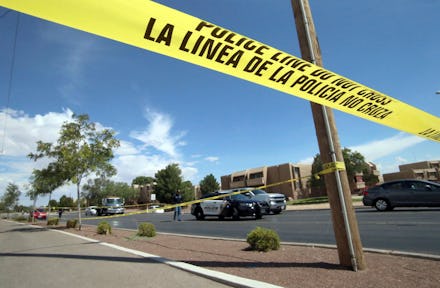Mass shootings can be contagious, so why are we still not treating them like a health crisis?

Bedlam erupted on the evening of August 6 in Times Square, when a typically congested summer crowd of tourists and sightseers suddenly rushed across streets and sidewalks seeking safety. They ducked into stores, restaurants, and even darkened Broadway theaters. However, spurring the stampede was not — as these people assumed — another gunman on a mission to log what could have been the nation’s fourth mass shooting in 10 days. (Three people were killed in Gilroy, California, on July 28; 22 were shot dead in El Paso, Texas, on August 4; and nine more lost their lives in Dayton, Ohio, the next day.) Thankfully, the sounds in Times Square were just from a backfiring dirt bike. Still, to those people out for an enjoyable evening in Manhattan, the loud popping was enough to spark panic — and with good reason.
Researchers in 2015, who studied shootings between 1998 and 2013, found that mass killings involving firearms are inspired by similar events in the immediate past. In other words: Violence quickly inspires more violence.
“What we found was that for the mass killings … there was significant evidence of contagion,” the study’s lead researcher, Sherry Towers, of Arizona State University, recently told NPR, reflecting on the relevant research. “We also found significant evidence of contagion in the school shootings.”
The researchers even narrowed down the window, in which this contagion could spread directly from an inciting incident, to about 13 days. They also noted that widespread media coverage of mass shootings may be part of the cause. “This idea is supported by the fact that contagion doesn’t appear to exist for crimes that don’t get as much national attention,” Brian Handwerk of Smithsonian.com summed up. “The team’s examination of mass shootings involving three or more victims but not necessarily any deaths found no evidence of contagion.”
Some people who fled Times Square Tuesday evening — at least 12 of whom police said were injured, some which resulted in broken bones — spoke of their acute awareness of the frequency of mass shootings in the United States. One woman told the New York Times the following day, “It isn’t a heightened sense of fear, but of reality.” Another added, “[P]eople in California know to stand under a door if there’s an earthquake,” but now, with the prevalence of large-scale gun violence, “I think that we all, as Americans, sort of know the drill.”
After the chaos subsided, Chief James R. Waters, who leads the New York Police Department’s Counterterrorism Bureau, said to the Times, “To the untrained civilian, it’s gunshots, and in a 24-hour news cycle and the tragedies of Dayton and El Paso, they’re not wrong.”
He added that the people in the crowd responded just as police ask them to — even though there was no actual gunfire — partly because images of mass shootings are so widespread in the media and individuals have constant access to them. “It’s on the screens. It’s on their iPhone. It’s in their pocket. You can’t escape it,” he said.
So naturally, people presumed the popping sounds were bullets, not a bike.
The 2015 study, which compartmentalized its data into state-by-state groupings, also found that “state prevalence of firearm ownership is significantly associated with state incidence of mass killings with firearms, school shootings, and mass shootings.” More guns do equal more mass shootings, and though President Donald Trump would have Americans believe mental illness is largely to blame for such incidents, Towers and her team “found no significant association between the rate of school and mass shootings and state prevalence of mental illness.”
Still, many are calling for the declaration of “a public health crisis” to combat gun violence. In the wake of the three recent shootings, on Sunday, August 4, CBS Sunday Morning ran a story where seven doctors collectively characterized mass shootings as “a national epidemic,” while the Centers For Disease Control and Prevention await Senate passage of a bill that would provide funding for studies of gun violence. Such research could pave the way for new preventative measures that would save lives.
But, as recently reported by Wired, though the House of Representatives has earmarked $50 million for gun violence prevention research, “Senate majority leader Mitch McConnell has tried as hard as he can to prevent bills that even mention firearms from seeing the light of day on the Senate floor he so mightily controls,” including that one.
“The Senate must quickly follow the House’s leadership,” representative Carolyn Maloney, democrat from New York, said this week, according to Wired. “Inaction kills.”